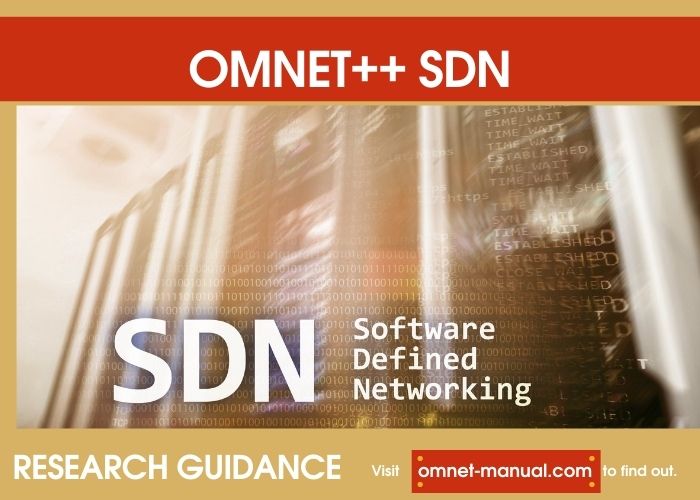What is OMNeT++? The term OMNeT++ stands for Objective Modular Network Testbed in C++. It is a typical C++ simulation tool and a modular simulator of library and framework to frame effective network simulators. It often denotes simulating the architectural performance of SDN-based applications and data.
“This article highly focuses on the performance of various versions of OMNeT++ SDN environments along its effective simulating process and the project scopes of the handpicked topic”
What is SDN?
The term SDN refers the Software Defined Networking, a method of network architecture, which makes the network gain smart and integral controlling or programming operations with the help of software applications. It steadies the user with all-around management of the whole network nevertheless the network technology underlying. Here are the steps involved in SDN.
- User Attaching request to SDN switch
- Forwarding the request to SDN controller
- Sends the user request to the server
- Server responds to the request
- Forwarding the response to SDN switch through the controller
- SDN switch sends the response to the user
- Server directly allocates the IP address to the user
The above-given steps are the major steps of the data transmission of SDN through the middle elements of SDN. Here we provide you with the overall advantages of OMNeT++ SDN
Uses of OMNeT++ SDN
OMNeT++ is a simulation tool through which we can gain the process of transmission that scheduled the service time to get the original message at the receiver side. SDN is used to transmit the data between the complex and static network architectures. This process can be completed with the help of conceptualizing the software based on its standards lying among the control plane and forwarding plane which combines the virtual and physical devices. Here are the important classes used in OMNeT++ in SDN environments.
Important classes in OMNeT++ for SDN
OF Controller
This type of class is used to achieve the process of open flow controllers like TCP or packet scheduling and transmission process. This class will also deal with the message process. The SDN isolates the control layer to determine the destination of the packet from the source. The separating process of the control layer takes place at the stage of decision making. The following are the protocols used in OMNeT++
Protocols in OMNeT++ with SDN
- Analytic Network Process (ANP)
This type of network process is used to analyze the multi-criteria decision. ANP is a common form of the Analytic hierarchy process. The AHP constructs a decision problem into a ranking order with a goal, and it provides substitutes, whereas the ANP works the above process into a network. Such multi-criteria decision analysis enables the user to select the top route in the environment based on SDN simulation.
- Link Layer Discovery Protocol (LLDP)
The Link Layer Discovery Protocol can be used in detecting topology. It functions to bring particularized vulnerabilities like discovering the link in the southbound interface. Such issues consider each application uses the LLDP packets to discover links. As the protocols are important in a network, algorithms are also important in a network simulator. Let’s take a look at the algorithms used in OMNeT++
Algorithms in OMNeT++ SDN
DPI Algorithm
DPI stands for Deep Packet Inspection in SDN technology which can integrate the technology and increases packet transmission. Here, we normally deploy a parallel DPI to the control layer. Comparing a DPI to the control layer and effectively decreases the packet detecting time of packets and flow table sending.

Applications in OMNeT++ with SDN
- NFV wireless applications and SDN develops the communication structure: SDN requires the network forwarding functions to detach the network control functions. But the NDF requires the hardware to provide the functions of network forwarding and networking. Both of these functions are relay on the virtualization distracts the network design and substructure from the software and executes it by keeping the software beyond the hardware devices and platforms.
- Applications based on Performance, scalability, interoperability, and on the performances of the control plane: the dares faced by the SDN are reliability, scalability, security, performance, and interoperability. The controllers of SDN should be configured intellectually and the topology of SDN is verified enough to avoid the manual errors and induce the availability of the network.
- HetNets Application based on SDN: we provide you a structure based on SDN, which permits the TTD and FDD systems to have effective resource sharing. The re-configuration mechanism in a TDD frame employs to improve the uplink proportion and the slots of the TDD picocell structure.
The above-mentioned concepts are the various types of applications used in OMNeT++ and SDN. The outputs may vary according to the functions of those applications. Here are the simulation steps involved in OMNeT++
Simulation Steps in OMNeT++ SDN
Step 1: along with the vehicles based on the sumo traffic model and SDN controller, we need to structure a Vehicular Ad hoc Network.
Step 2: based on the SUMO traffic model, we have to build a mobility road area and map.
Step 3: After the structuring process, we need to function the data transmission between the vehicles.
Step 4: choose the destination and source nodes from the network unsystematically.
Step 5: through multiple controllers of SDN and RSU, broadcast path request among source and destination
Step 6: Before choosing the optimal path, make a process of Optimal Path Functions.
Step 7: this could be the completing step, to accomplish the data transmission among the nodes of source and destination.
Step 8: this is the generating process, where we can generate a graph by comparing the number of vehicles with the following
- Routing overhead
- Throughput
- End-to-end delay
- PDR
The above-mentioned steps are the simulating process of the OMNeT++ for the SD network. These steps represent the secure SDN for routing in the VANET environment. Simulation is important for any network that analyses its effectiveness in data transmission. For SDN, the appropriate simulation tool is OMNeT++. Here we provide you the version of OMNeT++ tools used in SDN
OMNeT++ Tools version for SDN
- OMNeT++ 5.1
This network enables us the process of SDN by combining this tool with the framework of INET-3.6.0. This particular structure of the INET relies on the particularized OpenFlow switch during the process of simulation configuration. Thus, some changes are required as the IPv4Network Configurator and the EtherMACBase::registerInterface avoid the interface between the switches, and hence, the interface table doesn’t consider it, and also it is ignored by the FlatNetworkConfigurator.
- OMNeT++ 4.6
This tool can be used in implementing the process of end-to-end delay, lost packets, latency, jitter, and other QoS parameters. We can use the OMNeT++ 4.6 for every type of SDN topologies that are classified through the implementation of the OpenFlow protocol simulation. The classification of the topologies can be based on star, tree, and ring.
The above-discussed tools are our finest range of SDN OMNeT++ tools versions and their function. Apart from those versions, we put our effort into discovering and comparing the latest versions of OMNeT++ tools with the SDN. Here are our research developers’ suggestions on the recent research topics in OMNeT++ SDN
Recent Research Topics in OMNeT++ SDN
- Result analysis on SBMCNA with OMNeT++
- Using multi-level security mechanism for Modeling software in SDN environments
- Managing Unified mobility in heterogeneous 5G networks
- Analysis of QoS metrics in various SDN structures with OMNeT++ 4.6
- Performance analytics on OpenFlow for SDN with OMNeT++
For your reference, we displayed you a very few counts of research topics. We are having 100+ engineers in the networking field and they are updated with the relevant domain Omnet++ SDN and we are spreading our branches on the happiness of customers across 120 countries!! Thus we assure you an accurate project service and we are extending our support and guidance apart from the Software Defining Networking if you are interested to explore. So, join us, sit back and relax that we take care of the rest.
